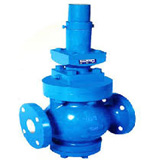- Call Us: +91-9925047484
- Email: hpvalves@gmail.com
Pressure Reducing Valve

THE COMPACT "HP" Make REDUCING VALVE OFFERS YOU GREATER PERFORMANCE AT A COMPETITIVE PRICE.
Built in Extra Features
Featuring a compact, efficient design, the HP Brand valve provides greater flow capacity and performance than most comparable models. Yet is economically priced. Special features range from a streamlined body that minimizes turbulence and pressure drop to erosion-resistant, hardened stainless steel trim.
Positive Dead End Shutoff
In the 'HP Brand' design, all main valves are single seated and normally closed. Initial pressure exerted on the main valve plug. Assisted by a main spring, forces tight closing. Special valves equipped with cobalt based overlays on trim to maintain premium tightness-guaranteed not to be cut by high velocity flow.
Lower First Cost
Integrally Mounted pilot saves installation and maintenance time-eliminating conventional "hang-on" pilots easily installed. Internal ports with fewer field connections reduce the number of joints-consequently reducing potential leak points.
Packless Construction
All main Valves and pilots are built without stuffing boxes. This means it is just freedom from packing and scoring to minimize maintenance costs and downtime because packless construction is a major contributor to the dynamic qualities. Packless construction eliminates leakage of gases to the atmosphere preventing costly loss.
Interchangeable Pilots
HP Brand designs have great advantages of interchangeability for all pilots on all sizes of main valves. Furthermore, the function of any main valve may be changed simply by substituting one type of pilot for another. E.g., the main valve may be converted from a pressure reducing valve to a back pressure regulator or a differential reducing regulator. The Practical advantage of interchangeable pilots is that a user of a number of HP Make Reducing Valve will find it very desirable to be able to convert the reducing valve from one service to another. The value and usefulness of 'mark one' is thereby greatly enhanced.
High Speed Response
'HP' Brand valves are destined for high-speed operation. The downstream pressure is transmitted to the sensing diaphragm without delay, through a connection integral with the valve. This results in a feedback that is faster than any other possible method. Hence and minimal inertia and travel of the moving parts, Response time can be in the millisecond range.
High Stability
Long guiding surfaces are ground to high finish on all moving parts to assure true alignment and stability. High speed is of little advantage unless coupled with stability and here lies a subtle benefit of our 'HP' that few have recognized.
Interchangeable Adjusting Springs
Five adjusting springs cover reduced pressure of 0.5 Bar up to 30 Bar. The springs are designed to give best performance and are colour coded for error free selection. Set pressure ranges are changed by simply replacing the adjusting spring without removing the pilot assembly and without any special tools.
Valve Sizing
The table lists the approximate flow co-efficient (Cv) for Reducing valves. It is recommended that valve sizing is confirmed by HP for this, the following minimum information is necessary.
| Valve Size MM | 25 | 40 | 50 | 80 | 100 |
| CV Standard Special | 105 | 2010 | 3515 | 7535 | 10550 |
Reduced Capacity Trim
Pressure and Temperature Ratings Body Materials
Carbon Steel Body ASTM A216 Grade WCB
A commonly used material suitable for a wide range of fluids when corrosion and extremely low or high temperatures do not present a problem.
Temperature Limits : 10 to +400° C
Maximum Pressure Cold Rating : 46 Bar (Steam, Air, Gases and Liquids)
Maximum Pressure/Temp.Rating : ( to ASME/ANSI B16.34)
Austenitic Stainless Steel ASTM A351 Grade CF-8/8M
A very widely used Stainless Steel recognized for its excellent corrosion resistant properties in the presence of chlorides.
Temperature Limits : 40 to +400° C
Maximum Pressure Cold Rating : 42 Bar (Air, Gases and Liquids)
Maximum Pressure/Temp.Rating : (To ASME/ANSI B16.34)
H.P. MAKE PRESSURE REDUCING VALVE OPERATION :
A relay or pilot-operated reducing valve for steam services is shown in figure.
It comprises :
(i) The valve body which contains the main valve, the seat and the piston assembly. (ii) The control head which houses the pilot valve assembly with its associated diaphragm and main adjusting spring.In this type of reducing valve the main valve is opened by the action of inlet steam on top of the piston which is supplied via the inlet relay port and pilot valve. The pilot valve itself is controlled by the combined action of reduced pressure under the diaphragm and the adjusting spring above it.
The pilot valve opening (and hence the pressure on top of the piston) is controlled by the combined effect of reduced pressure acting on the underside of the diaphragm via the low pressure port. The pilot valve spring. And the load exerted on the top of the diaphragm by the adjusting spring. By this means, the slightest variation in reduced pressure affects the opening of the pilot valve and hence the pressure on top of the piston.
The main valve opening is thus automatically adjusted by the reduced pressure which is accurately maintained despite variations of inlet pressure and/or capacity.
NOTE :
| Technical Specification |
| Size Range | 25mm to 150mm |
| Moc | Cast steel, SS 304,SS 316 |
| Trims | SS 304 |
| Type | Pilot Operated |
| End Connection | Flanged End |
| Pressure Rating | 300 class |
